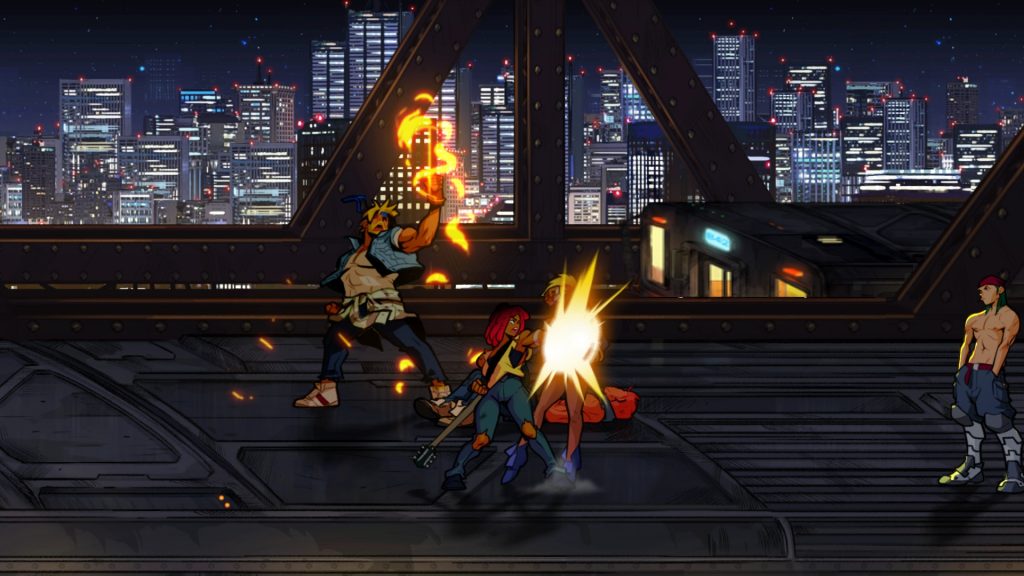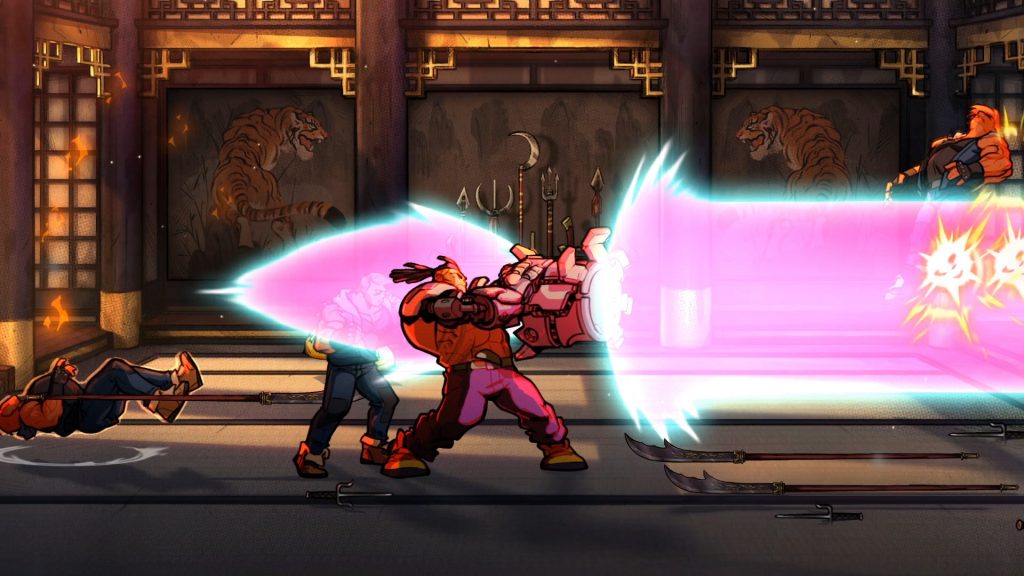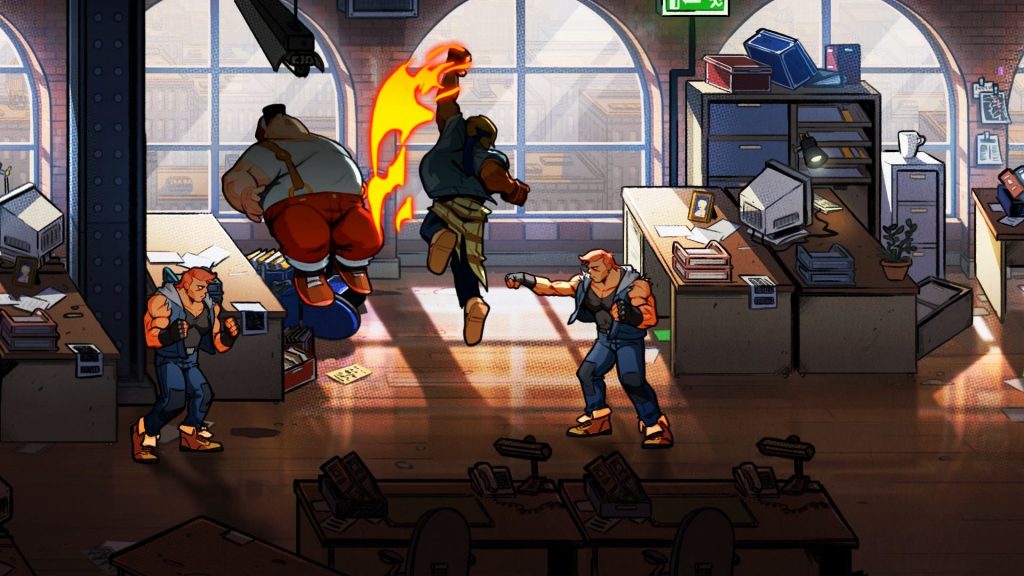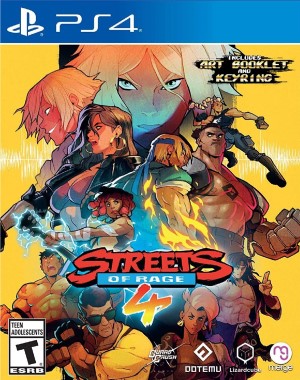
In 26 years since the release of Streets of Rage 3, gaming has evolved into an almost entirely different form. A franchise like Streets of Rage, a brutally difficult sidescrolling arcade fighter that has to be beaten in one sitting, seems like it should have no business fitting into modern gaming. Yet, developer Lizardcube has found a way to not only make Streets of Rage work, but it has found a delicate balance between evoking the past and injecting the present to create a dazzling product that enhances both. Despite some inconsistencies, Streets of Rage 4 balances exhilarating and challenging old school combat with modern graphical and structural touches, bringing back the best of the franchise while reinvigorating it for a new generation.
Set ten years after the events of the last game, Streets of Rage 4 sees the Syndicate back in the city with a new plot to take it over, and it’s your job to stop them by progressively taking down their higher-ups and foiling their plots. It’s a story that fits well into the world of the franchise, containing a lot of familiar faces while introducing some new heroes and villains alike.
"The two newcomers, Cherry and Floyd, have more distinct styles compared to the mostly balanced traits of the returning three."
Each stage begins and ends with cutscenes that range from central to the story to almost nonexistent, and they mostly serve to give context to the upcoming stage. While there are hints of the lore and a lot of secrets to uncover that give more depth to the plot and call back to past games, the story generally takes a backseat to the gameplay by getting in and out without overstaying its welcome.
Fans of the series will immediately be familiar with Streets of Rage 4’s traditional sidescrolling beat-‘em-up structure. Backed by a brilliant retro soundtrack, each stage has you fight through waves of enemies and mini-bosses as you attempt to reach and defeat a boss. You can do this with one of five playable characters. Returning from previous games are Axel, Blaze, and Adam, each of which has their own style that closely matches those from past entries.
The two newcomers, Cherry and Floyd, have more distinct styles compared to the mostly balanced traits of the returning three. Cherry is fast and agile, while Floyd is slow and powerful. The entire story can be played solo or in up to four player co-op for the first time, which, though co-op can make for some chaotic on-screen moments, is another enjoyable way to play through each level and bring your friends into the action.
"Every attack packs a satisfying punch, and filling up a combo into the dozens or hundreds always felt good, especially when you finally start to get the hang of a character."
Each stage is impressively diverse in both gameplay and design, and, while they all have a consistent structure, they can range from a static police precinct to a moving train or airplane with environmental hazards. None of the stages are particularly suited for one style, so there is some incentive to learn and master one character at a time or to have multiple different characters going in co-op. I gravitated toward Cherry’s speed and Adam’s balance. Each character has their own unique and beautifully animated abilities, from the standard quick attacks that easily create combos to the more powerful special attacks.
By draining health that can only be regenerated by attacking further, these are great ways of forcing the action and keeping the pace of gameplay up. The star attacks are much more uncommon and powerful, usually able to disperse an area of enemies. Along with being ridiculously powerful, these are also tools for filling in details of each character’s persona that the overarching storyline can’t, like Floyd’s cybernetic arms and Cherry’s guitar. Regardless, every attack packs a satisfying punch, and filling up a combo into the dozens or hundreds always felt good, especially when you finally start to get the hang of a character.
As a retro arcade game, the Streets of Rage series is known for its difficulty and unforgiving combat, and 4 lovingly brings that difficulty back, but with modern sensibilities. While it thankfully doesn’t force you to play through the entire game without dying to see the finale, unless you’re playing on Arcade Mode, levels can still be brutally difficult before you understand their layout or your character’s strengths.
"While there are twelve main stages in the story, the true value comes from the replayability of each stage."
Without any score-decreasing power-ups, you’re given two extra lives before it’s game over and you have to restart the stage. While it seems like a lot at first, you’ll quickly be surrounded by powerful enemies that can take half your health down without warning and ultimately kill you over and over again.
With its difficulty, Streets of Rage 4 toes a thin line between frustrating and exhilarating. You’ll sometimes get a boss down to its final stages just to be swallowed up and thrown back to the start of the level, but when you get back to the boss, you’ll be much more prepared to beat it. The more frustrating aspects come in the earlier areas of each stage.
While there’s a gameplay balance that you have to strike to be able to take on a group of enemies at once, there are times where certain enemy attacks, and ultimately your deaths, can become almost frustratingly unavoidable. There’s also a disheartening feeling when you’re seemingly in line with an enemy to attack and miss because you’re indistinguishably above or below their line.
Bosses are entirely different beasts, too. Returning bosses like Barbon and Shiva throw back to past entries and fight mostly hand-to-hand, while new bosses like Diva and DJ K Washi add other interesting elemental abilities that change the flow of the fights. They act as the culmination of each level, and, as such, can be the most difficult parts of the experience. But being as diverse in design and challenging in combat, they are also the highlights. Slowly coming to understand the bosses’ move sets and ultimately taking them down after multiple attempts are some of the most exciting and exhilarating moments of the game, and with frustration and difficulty being a primary aspect of the experience, it only makes it more rewarding to put everything together to beat a level.
While there are twelve main stages in the story, the true value comes from the replayability of each stage. One perfect playthrough might only take 2-3 hours, but with deaths and game over screens, your first playthrough will probably take between 6 and 8.
"Even if I would get frustrated at my own mistakes and deaths in the moment, Streets of Rage 4 never gave me a reason to quit, as long as I’d be willing to try another stage just one last time."
Afterwards, though, there’s so much else to do. You’re encouraged to replay each level on higher difficulties with other characters, which gets you more points toward unlocking more characters from past games. Replaying stages to learn their idiosyncrasies to allow you to beat them on higher difficulties is where it truly feels like you’re playing in an arcade and trying to get as much value as possible on that last quarter, which is where the game really shines. And, while not essential, the Boss Rush and Battle modes add a little extra variety to spice up the experience.
As a continuation of a series that began with the sidescrollers of gaming’s past, Streets of Rage 4 succeeds in creating an experience that infuses modern gaming into the core of those arcade classics. While its difficulty can be a turn off, its shining moments are in its consistency and progression from stage to stage and the reward that pushing through and finally completing a particularly hard level can provide. Even if I would get frustrated at my own mistakes and deaths in the moment, Streets of Rage 4 never gave me a reason to quit, as long as I’d be willing to try another stage just one last time.
This game was reviewed on PC.
Fluid gameplay; Rewarding challenges; Beautiful retro presentation; Vast replayability.
Some difficulty hiccups; Inconsistent story.



















